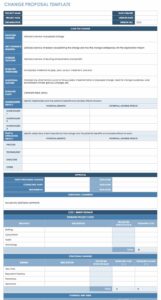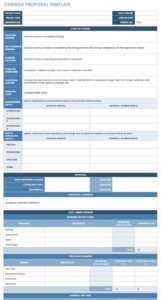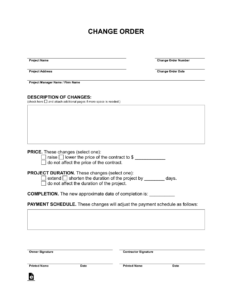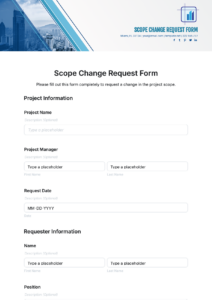Utilizing a predefined structure for alteration proposals offers several advantages. It streamlines the process, reducing ambiguity and ensuring all necessary information is captured. This structured approach promotes better decision-making by providing a consistent framework for evaluating the impact and feasibility of proposed changes. Furthermore, it enhances collaboration among team members and stakeholders, fostering a more organized and controlled development environment. By creating a clear audit trail of modifications, it also improves project transparency and accountability.
Understanding the purpose and benefits of this organized approach to modification management sets the stage for a deeper exploration of practical implementation and best practices. Subsequent sections will delve into the key components of these forms, offer guidance on their effective utilization, and showcase real-world examples to illustrate their value in maintaining project quality and efficiency.
Key Components of a Change Request Form
Effective management of software modifications requires a structured approach. Essential elements within a formalized request ensure clarity, traceability, and efficient processing of proposed alterations.
1. Unique Identifier: A unique number or code assigned to each request allows for easy tracking and referencing throughout the project lifecycle.
2. Requestor Information: Identifying the individual or team initiating the change provides context and facilitates communication.
3. Date of Request: Timestamping the request allows for accurate record-keeping and prioritization based on submission time.
4. Description of Change: A clear and concise explanation of the proposed modification, detailing the desired outcome, is crucial for proper evaluation.
5. Rationale/Justification: Explaining the reasons behind the change, including the problem being addressed or the benefit being sought, helps stakeholders understand the necessity and value of the modification.
6. Impact Assessment: Evaluating the potential effects of the change on different aspects of the project, such as functionality, schedule, and resources, allows for informed decision-making.
7. Priority Level: Assigning a priority level (e.g., critical, high, medium, low) helps determine the urgency and order in which requests are addressed.
8. Affected Components/Modules: Specifying the parts of the software affected by the change allows developers to focus their efforts and minimize disruption.
9. Proposed Solution: A description of the technical implementation plan for the change, outlining the steps required to execute the modification.
10. Approval Status: Tracking the approval status (e.g., pending, approved, rejected) ensures proper governance and accountability.
These components provide a comprehensive framework for documenting and managing software modifications, ensuring thorough consideration and efficient implementation of changes while minimizing potential risks and disruptions.
How to Create a Software Development Change Request Template
Establishing a standardized template ensures consistent and efficient management of modifications throughout a software project’s lifecycle. The following steps outline a practical approach to creating such a template.
1. Define Required Fields: Begin by identifying the essential information needed to document a change request comprehensively. This typically includes a unique identifier, requestor details, date, description of the change, rationale, impact assessment, priority level, affected components, proposed solution, and approval status.
2. Select a Format: Choose a suitable format for the template, considering accessibility and ease of use. Common options include word processing documents, spreadsheets, or dedicated change management software.
3. Design the Layout: Structure the template logically, grouping related fields for improved clarity and readability. Clear headings and concise instructions should guide users through the completion process.
4. Implement Input Validation: Where applicable, incorporate input validation to ensure data integrity and consistency. This might include dropdown menus for predefined options or mandatory fields to prevent incomplete submissions.
5. Establish a Review Process: Define a clear workflow for reviewing and approving change requests. This process should involve relevant stakeholders and ensure appropriate levels of authorization are obtained before implementation.
6. Pilot Test and Refine: Conduct a pilot test of the template with a small group of users to identify any areas for improvement. Gather feedback and refine the template accordingly before wider deployment.
7. Train Personnel: Provide training to all team members on the proper use of the template and the associated change management process. This will ensure consistent application and maximize the template’s effectiveness.
8. Periodically Review and Update: Regularly review and update the template to ensure it remains aligned with project needs and best practices. This continuous improvement approach will maintain its relevance and effectiveness over time.
A well-designed template, combined with a clear process, provides a robust framework for managing software modifications effectively. This structured approach minimizes risks, improves communication, and ensures project stability.
Effective management of modifications is crucial for successful software development. Standardized forms provide a structured mechanism for proposing, evaluating, and implementing changes, ensuring clarity, traceability, and accountability throughout the project lifecycle. Key components, such as unique identifiers, detailed descriptions, impact assessments, and approval statuses, contribute to a comprehensive record of modifications, facilitating informed decision-making and minimizing potential disruptions. A well-defined process, coupled with a user-friendly template and adequate training, ensures consistent application and maximizes the benefits of this structured approach.
Organizations committed to delivering high-quality software must prioritize robust change management practices. Adopting standardized procedures for documenting and processing modifications contributes significantly to project success, fostering better communication, reducing risks, and enhancing overall product quality. A proactive and organized approach to change management is an investment in project stability and long-term success.



